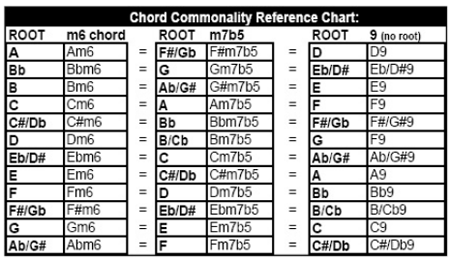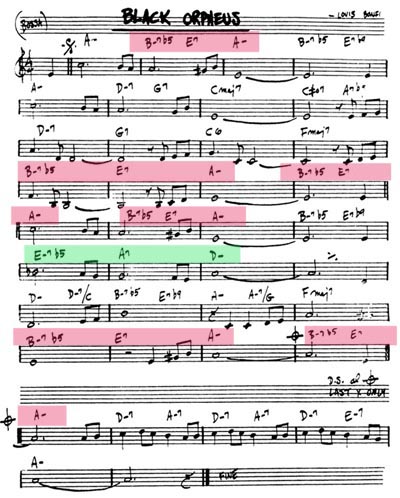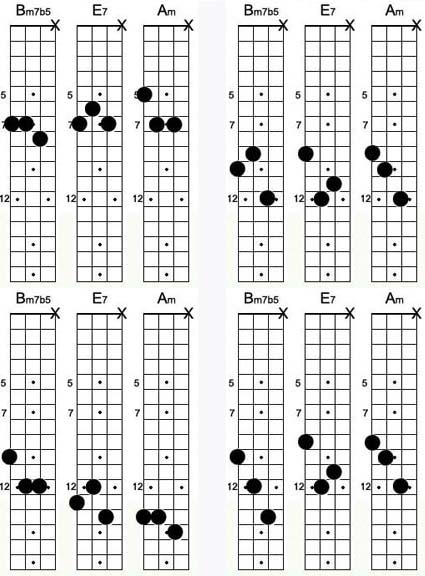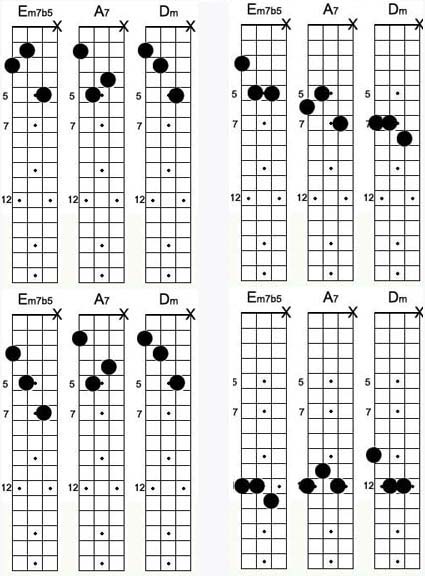« February 2013 |
Main
| April 2013 »
 March 28, 2013 | Chord Commonalities
March 28, 2013 | Chord Commonalities
In our August 2005 archive issue of Mandolin Sessions, we discussed how particular chords could have a different flavor or mood, depending on the context. Since we've explored a lot of ways to streamline extended chords into three simple notes, we thought it opportune to dig this issue up. In particular, we mentioned the four notes of a m6 chord where the same as a m7b5 and a rootless 9th chord.
Read article: Chord Commonalties; m6, m7b5, rootless 9th
Am6 = A C E F# * F#m7b5 = F# A C E * D9 (rootless) = (no D) F# A C E
We created a handy reference chart for you to visualize this.

What's interesting is how the same set of notes F# A C E can be used in each of the three different "planets" of the Tonal Universe.

Am6 can be a Tonic chord, with an added voice for color. All chords progress to Am in the key of A minor.
F#m7b5 can be a Dominant Preparation chord. It is the iim7b5 chord in the key of E minor.
D9 (rootless) can be a Dominant chord. It is the V7 chord in the key of G Major (or Minor).
F# A C E. Same notes, different hats.
Sometimes when you throw out a set of notes, you don't always know where you are going. It pays to listen to what's going on around you!
Further:
Chord Commonalties; m6, m7b5, rootless 9th
Tasty Major landing chords
Chord Economy
Fourthness and Purple
Take Three
Posted by Ted at 12:47 PM
 March 21, 2013 | Best of JM: Jazz and Bluegrass; How close?
March 21, 2013 | Best of JM: Jazz and Bluegrass; How close?
Enjoy the popular archive material below.
From December 17, 2009 | Jazz and Bluegrass; How close?)
NPR has a terrific online article in their weekly "Take Five: A Weekly Jazz Sampler" series highlighting five incredible "hybridized" audio tracks from some progressive fret musicians including Bela Fleck, Alison Brown, David Grisman, Andy Statman, and Tony Rice. The thrust of the article is the similarities between the genres, and we concur. Despite the differences in complexity of chord structure (including complicated chord extensions and rapidly shifting tonal centers) and urban vs. rural origin, there remains several common threads between the uniquely American grown styles.
Take some time to listen to the tracks.

Read article: NPR Take Five: A Weekly Jazz Sampler; Jazz and Bluegrass
Just what are the similarities between jazz and bluegrass?
Variations on a Theme. You'll find jazz and bluegrass thrive on the conflicting elements of predictability and exploration. Both use the familiar tune as a jumping off point for improvisation and deviation, taking the rest of the ensemble and the audience on a creative journey, but the basic background chord structure remains the same. There is always a fabric of familiarity, something for the players to keep in common as they try new melodic riffs and explore the registers of their instrument using rhythmic motifs from the original melody.
Moments of virtuosity. The degree of "flash" varies with the level of musicianship, but it can be argued that both formats give the player the opportunity to be him/herself. You can get the blistering Dizzy Gillespie gymnastics, or the finesse and subtle nuance of tone in Miles Davis. You can get the unique signature styling of Bill Monroe, or the melodic dynamo and fretboard pyrotechnics of Ricky Skaggs.
Common library of "standards." Both styles are easily participatory with a good working knowledge of several dozen "classic" tunes. With a respectful musical ability, you can sit in on most jam sessions equipped with these familiar tunes in your quiver. Bluegrass has its own set of common songs, and of course jazz has its "standards," documented in what's established as a "Real book." It's amazing how no matter where you go on the planet, you'll find a commonality of songs.
Universal format of performance. Participation carries a common set of community "rules." Those who gather will let someone set the tempo, kick off the tune. There may be discussion prior as to who will take solos, or there will be an organic "understanding" of who goes next. In a good session, players will be considerate of their soloing time, reciprocate, and not hog the show. Of course every jam or performance will have its own outcome and variety of individual personality, but jazz and bluegrass are amazingly similar in the trade-off.
It's all good.
Further:
Tuneage: Sample Jazz Standards Set List
Plays Well With Others...
Analysis: Macroscopes and Microscopes Part 1
Respect the Silence
Posted by Ted at 7:48 AM
 March 14, 2013 | Applying minor chord blocks--Black Orpheus
March 14, 2013 | Applying minor chord blocks--Black Orpheus
We've gone through the theory and we showed several different ways to grip the chords that comprise the most basic sentence of Western European music, the 'ii V7 I' and it's dark sister 'ii7b5 V7 i' the last few Tips and Tricks columns. It's one thing to have the vocabulary, quite another to use it in context. Knowing a few words in Spanish will only be beneficial if you know how to string them in a sentence, "Perdone, ¿d ónde estáel baño?"
We want to take some of our most recent blocks and apply them to a favorite Louis Bonfi jazz standard, Black Orpheus. Hopefully, you've had the chance to play through some of last week's minor 'ii7b5 V7 i' progressions, and of course we encouraged you to experiment with the fingerings in different keys. By the way, we did address an incorrect spelling of the Dm7b5 chord, so if you already printed it, you'll want to change to the recent version. This time, we'll extract two tonal centers and map them out for you, A minor and D minor.

We've highlighted them with two different colors. All four grips are mapped out for you below. Of course a couple may not be that practical because of the their stratospheric position on the fretboard, but you can get the idea of how versatile these basic positions are.
Pink=A minor

Now we'll do the same for the D minor tonal center. Note a lot of jazzers with use a V7b9 instead of a straight V7 in this tune, but we wanted to keep this basic for now. We left off the b9 extension. Enjoy:
Green=D minor

Here's a link for listening to the tune and playing along with it. Repetition will help you learn them, and you can try applying them to other minor songs.
Black Orpheus Fakebook 
Further
m7b5 Chords
Major 'ii V7 I' 3-note Mandolin Chord Blocks
'ii V7 I' and 'ii7b5 V7 i' Home Positions
Vamps. Minor modal
ii7b5 V7 i Minor Patterns
Posted by Ted at 2:33 PM
 March 7, 2013 | Minor 'ii7v5 V7 i' chord blocks
March 7, 2013 | Minor 'ii7v5 V7 i' chord blocks
Two weeks ago, we introduced a series of chord progressions that would allow you to voice the most common musical "sentence" in Western European music. In jazz, it's the equivalent to earth, wind, and fire, the elemental vocabulary, labeled "ii V7 I." It's not the first time we've covered this, but in our expanding series of 3-note chords, we wanted to equip you with some basic stock chord "grips."
Last week we injected some more colorful "landing" chords. You'll recall we wanted to simplify the voicings initially, sans extended harmonic extension bling. We took the liberty of adding some Major 7th and juicy Add 9 variations to give it some color.
It was all about Major modes, and you're probably already wondering, "what do we do about the Minor modes?"
Wonder no more...
Download PDF:  Minor 'ii7b5 V7 I' 3-note Mandolin Chord Blocks Minor 'ii7b5 V7 I' 3-note Mandolin Chord Blocks

This time around we equip you with four stock patterns you can build off in the minor keys. As we mentioned before, you'll want to get them into your fingers, not just in the keys on the PDF, but start to move them around. Move them up two frets and you've got the next key up.
Em7b5 A7 Dm becomes F#m7b5 B7 Em
Am7b5 D7 Gm becomes Bm7b5 E7 Am
F#m7b5 B7 Em becomes G#m7b5 C#7 F#m
Dm7b5 G7 Cm becomes Em7b5 A7 Dm
Take the 2nd and 3rd sets and move them down two frets. If you have trouble memorizing or transposing in your head, write them out on blank mandolin chord template paper for yourself.
Next week we'll look at some songs in minor keys that use these so get the chord to chord motion in your hands.
Further
Major 'ii V7 I' 3-note Mandolin Chord Blocks
'ii V7 I' and 'ii7b5 V7 i' Home Positions
Vamps. Minor modal
m7b5 Chords
ii7b5 V7 i Minor Patterns
Posted by Ted at 5:57 AM

Disclaimer: In the 'Information Age' of the 21st Century,
any fool with a computer, a modem, and an idea can
become a self-professed 'expert." This site does not
come equipped with 'discernment.'
|



